3 PERIODS OF INDIAN BUDDHIST HISTORY
- Thứ ba - 22/09/2020 04:02
- In ra
- Đóng cửa sổ này
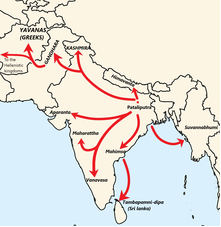
3 PERIODS OF INDIAN BUDDHIST HISTORY
PEACEFUL PERIOD (594 BCE – 185 BCE)
DECADENT PERIOD (185 BCE – 1526 BCE)
RESTORING PERIOD (1858 CE – 2013 CE)
I – IN PEACEFUL PERIOD (594 BCE- 185 BCE):
A – Developing and peaceful in Buddha `s times:
Before Lord Buddha `s birthday, there were alot of religions and human beliefs in India. For example: Hindhuism, Jain, ect.. After Lord Buddha enlightened the truth under Bodhi tree, then He preached Buddhism. From that time, Buddhism would be one of religions in India. Based on Mahayana Buddhism was as following:
b) The most development of Buddhism in Ashoka `s dynasty 268 – 232 BCE:
In the 3rd century 268 – 232 BC, Buddhism had been spred whole country and oversea by Ashoka king.
Ashoka king was born in 304 BC at Pataliputta kingdom (Now Patna capital, Bihar state). His father was Bindusara Maurya; Mother was Devi Dharma. Chandragupta Maurya was his grandfather. He was also founder of Maurya dynasty. He left his kingdom for to be a Jain monk.
From year 268 – 232 BC, He became a King; Ashoka king was the third one of Maurya dynasty. Since, He became a King; He pred his power from Assam in eastern to Balochistan in western; and from Pamir Knot in Afghanistan in northern to Peninsula in southern. So the 3 rd century BC to 20 century year 1947, India, Afghanistan, Pakistan and Bangladesh had been united one country.

Map in Ashoka king `s emperor
In 263 BCE, Ashoka king became a Buddhist. He realized that Buddhism was a basical morality for human being. So, He supported and builded many monasteries and set up all historiscal monuments of Lord Buddha.
Ashoka king supported for the 3rd Tripitaka assemble in 244 BCE in Pataliputta kingdom (At Patna Capital, Bihar state now). He allowed prince Mahinda and princess Sanghamitta becoming a Monk and a Nun. Miss Sanghamitta brought a branch of Boddhi tree from Bodhgaya and She planted it in Sri Lanka. Particular, She organised Bhikhuni ceremony and She transmitted Bhikhuni silas to Sri Lanka nuns.
Ashoka king was the first king who sent all monks to Myanmar, Sri Lanka and Asian countries for propagation of Buddhism.
Year 232 BCE, Ashoka king died. The Maurya dynasty had 9 dynasties; It last from 322 – 180 BCE.
In 3rd century, 268 BCE – 20th century 1947 CE, Ashoka king had united India, Afganistan, Pakistan, and Bangladesh becoming one country. It lasted about 23 centuries. In 20th century 1947 CE, India had been independence. At the same time, India had been aparted 4 countries such as: India, Afghanistan, Pakistan and Bangladesh. During his times, Ashoka king carved on sand stone pillars about lord Buddha `s history. Therefore, Archaeological Survey of India based on these pillars for to confirm lord Buddha `s historiscal sites.
1 - You can reseach more informations about Ashoka king `s history by the link below.
https://en.wikipedia.org/wiki/Ashoka
2 – You can research History of Buddhism by the link below.
https://en.wikipedia.org/wiki/History_of_Buddhism
+ Resumary:
From the 6th century 594 BCE until the 2nd century 185 BCE, Buddhism had been propagated everywhere During four centuries. All most the kings and peoples worshiped Lord Buddha. So, we can say that Buddhism had been pretty peaceful.
III – DECADENT PERIOD OF INDIAN BUDDHISM (185 BCE – 1526 CE):
During 2nd century BCE the Sanchi stupa was nearly doubled in diameter, was encased in stone, and a balustrade and railing was built around it.[50]
The Shunga dynasty (185–73 BCE) was established about 50 years after Ashoka's death. After assassinating King Brahadrata (last of the Mauryan rulers), military commander-in-chief Pushyamitra Shunga took the throne. Buddhist religious scriptures such as the Aśokāvadāna allege that Pushyamitra (an orthodox Brahmin) was hostile towards Buddhists and persecuted the Buddhist faith. Buddhists wrote that he "destroyed hundreds of monasteries and killed hundreds of thousands of innocent Monks":[51] 840,000 Buddhist stupas which had been built by Ashoka were destroyed, and 100 gold coins were offered for the head of each Buddhist monk.[52][better source needed]
Pushyamitra Shunga was the first king who started destroyed Buddhism. After that, many other kings continued to suppress Buddhism until the 13th century 1206 CE.
https://www.youtube.com/watch?v=wM98m3mkS1w
2 - In 13th century 1206 CE – 16th 1526 CE, Buddhism had been destroyed by Turkic Muslim emperor:
+ You can research the link below:
https://en.wikipedia.org/wiki/History_of_Buddhism
A milestone in the decline of Indian Buddhism in the North occurred in 1193 when Turkic Islamic raiders under Muhammad Khilji burnt Nālandā. By the end of the 12th century, following the Islamic conquest of the Buddhist strongholds in Bihar and Bengal by Delhi Sultanate's Muhammad bin Bakhtiyar Khalji, and the loss of political support coupled with social pressures, the practice of Buddhism retreated to the Himalayan foothills in the North and Sri Lanka in the south. Additionally, the influence of Buddhism also waned due to Hinduism's revival movements such as Advaita, and the rise of the bhakti movement.
+ Commentary:
Through Indian history, the reseachers said that not only Turkic Muslim, but also Hindhuism destroyed Buddhism.
III – RESTORING OF BUDDHISM in 19th and 20th centuries:
India was colony under England from 19th century 1858 CE – 20th 1947 CE, total is 89 years. During this times, Buddhism had been restored again by four Buddhists as following:
1 – By the founder Alexander Cunningham of Archaeoligical Survey of India (1814 – 1893):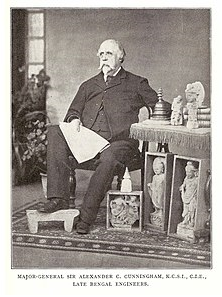
Alexander Cunningham
You can reseach the link below:
https://en.wikipedia.org/wiki/Alexander_Cunningham
Major General Sir Alexander Cunningham KCIE CSI (23 January 1814 – 28 November 1893) was a British army engineer with the Bengal Engineer Group who later took an interest in the history and archaeology of India. In 1861, he was appointed to the newly created position of archaeological surveyor to the government of India; and he founded and organised what later became the Archaeological Survey of India.
He wrote numerous books and monographs and made extensive collections of artefacts. Some of his collections were lost, but most of the gold and silver coins and a fine group of Buddhist sculptures and jewellery were bought by the British Museum in 1894.[2]
ASI was founded in 1861 by Alexander Cunningham who also became its first Director-General. The first systematic research into the subcontinent's history was conducted by the Asiatic Society, which was founded by the British Indologist William Jones on 15 January 1784. Based in Calcutta, the society promoted the study of ancient Sanskrit and Persian texts and published an annual journal titled Asiatic Researches. Notable among its early members was Charles Wilkins who published the first English translation of the Bhagavad Gita in 1785 with the patronage of the then Governor-General of Bengal, Warren Hastings. However, the most important of the society's achievements was the decipherment of the Brahmi script by James Prinsep in 1837. This successful decipherment inaugurated the study of Indian palaeography.
+ Summery:
Mr Alexander discovered a lot of historiscal sites of India. Particularly, He found out all Buddhist historiscal sites. Therefore, all Buddhist in the world can visit all Lord Buddha `s holyland. We are sincerely to pay grateful toward Mr Alexander Cunningham.
2 - ÔNG ANAGARIKA DHAMMA 1864 – 1833 CE: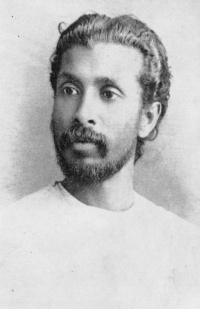
https://theosophy.wiki/en/Anagarika_Dharmapala
The child attended a succession of Christian schools near his home in Colombo. Buddhist education had been suppressed by colonial administrations of the Portuguese, Dutch, and English. He was educated at the Church Mission Society's Christian College, Kotte; St Benedict's College in Kotahene, run by Roman Catholics; St. Thomas' College in Mt. Lavinia, a boarding school operated by Anglicans; and Colombo Academy (now Royal College). Bible studies and English language dominated the curriculum. Don David learned the tenets of Christianity thoroughly, but was repelled by the violence in the Old Testament and by meat consumption by his teachers. He held close to his early Buddhist training. At the age of eighteen, he left school: I stayed at home for a while and devoured the books in the Pettah Library opposite my father's place of business. I read everything – ethics, philosophy, psychology, art and especially biography and history. I read many English poets, but always I would go back to Shelley, whom I had for years adored."[1]
His father encouraged him to take a clerical position in a government office, but when he was twenty years-old, against protests from his family, he left for Adyar and joined the Theosophical Society.
As soon as I touched with my forehead on the Vajrasana a sudden impulse came to my mind. It prompted me to stop here and take care of this sacred spot so sacred that nothing in this world is equal to this place where Prince Sikhdartha gained Enlightenment under the Bodhi Tree.[23]
Mahabodhi Temple at Bodh Gaya
On May 31, 1891, the Budh-Gaya Mahabodhi Society was formed. The High Priest of Ceylon H. Sumangala was President, Col. Olcott was Director and Chief Advisor, and Dharmapala was General Secretary. The new Society solicited contributions to maintain a staff at the Buddha Gaya site. The Society convened an International Buddhist conference at Buddha Gaya in October, 1891. Headquarters were established in Calcutta (now Kolkata). A journal, The Maha Bodhi began publication in 1892, with Dharmapala serving as editor for many years. While staying in England in 1893, he contacted William Rhys Davids, founder of the Pāli Text Society, for advice about the temple.[24] Over the course of a number of years, the Maha Bodhi Society succeeded in restoring the ancient Buddhist shrines at Bodh Gaya, Sarnath, and Kushinara. Substantial donations by Hawaiian Theosophist Mary E. Foster facilitated this work.
The Society was effective in raising the consciousness of Buddhists about their heritage in India and Ceylon, and in increasing knowledge of Buddhism in the Western world. During his years with the Society, Dharmapala established Upasana Centres, libraries, schools, colleges, orphanages and hospitals in India and Sri Lanka to serve the general public. He was a strong advocate of independence both in India and Sri Lanka.
The Maha Bodhi Society of India continues actively in Kolkata, and related organizations are in Bangalore, Chennai, Colombo, and elsewhere.
+ Summery:
Mr Alexander Cunningham found out all Buddhist sites; Mr Anagarika Dhammapala established Maha Bodhi Society in order to take care of them. He had great contributions to Buddhism, education and charitable works in India. We are sincerely to pay grateful toward Him.
3 – Mr Ambekar 1891 – 1956 CE: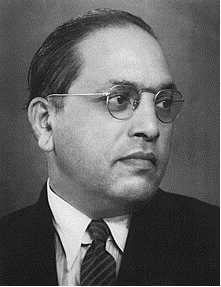
Bhimrao Ramji Ambedkar
You can research the link below
https://en.wikipedia.org/wiki/B._R._Ambedkar
Ambedkar was a prolific student, earning doctorates in economics from both Columbia University and the University of London, and gaining reputation as a scholar for his research in law, economics and political science.[15] In his early career, he was an economist, professor, and lawyer. His later life was marked by his political activities; he became involved in campaigning and negotiations for India's independence, publishing journals, advocating political rights and social freedom for Dalits, and contributing significantly to the establishment of the state of India. In 1956, he converted to Buddhism, initiating mass conversions of Dalits.[16]
In 1990, the Bharat Ratna, India's highest civilian award, was posthumously conferred upon Ambedkar. Ambedkar's legacy includes numerous memorials and depictions in popular culture.
Main article: Dalit Buddhism
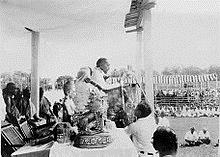
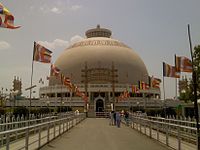
Ambedkar delivering speech during mass conversion
Ambedkar considered converting to Sikhism, which encouraged opposition to oppression and so appealed to leaders of scheduled castes. But after meeting with Sikh leaders, he concluded that he might get "second-rate" Sikh status.[100] Instead, around 1950, he began devoting his attention to Buddhism and travelled to Ceylon (now Sri Lanka) to attend a meeting of the World Fellowship of Buddhists.[101] While dedicating a new Buddhist vihara near Pune, Ambedkar announced he was writing a book on Buddhism, and that when it was finished, he would formally convert to Buddhism.[102] He twice visited Burma in 1954; the second time to attend the third conference of the World Fellowship of Buddhists in Rangoon.[103] In 1955, he founded the Bharatiya Bauddha Mahasabha, or the Buddhist Society of India.[104] He completed his final work, The Buddha and His Dhamma, in 1956 which was published posthumously.[104] After meetings with the Sri Lankan Buddhist monk Hammalawa Saddhatissa,[105] Ambedkar organised a formal public ceremony for himself and his supporters in Nagpur on 14 October 1956. Accepting the Three Refuges and Five Precepts from a Buddhist monk in the traditional manner, Ambedkar completed his own conversion, along with his wife. He then proceeded to convert some 500,000 of his supporters who were gathered around him.[102][106] He prescribed the 22 Vows for these converts, after the Three Jewels and Five Precepts. He then travelled to Kathmandu, Nepal to attend the Fourth World Buddhist Conference.[103] His work on The Buddha or Karl Marx and "Revolution and counter-revolution in ancient India" remained incomplete.
Mr Ambedkar died on december 06 1956. At first, He contributed the indian constitution. The second, He converted a lot of peoples becoming Buddhists. His works made great contributions to Buddhism.
4 - Mr Goenka (1924 – 2013 CE):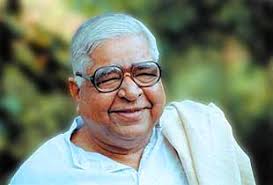
Satya Narayan Goenka
Please, research the link below:
https://en.wikipedia.org/wiki/S._N._Goenka
Satya Narayan Goenka (ISO 15919: Satyanārāyaṇ Goyankā; Burmese: MLCTS: u: gui ang ka; 29 January 1924 – 29 September 2013), commonly known as S. N. Goenka, was an Indian teacher of Vipassanā meditation. Born in Burma to an Indian business family, he moved to India in 1969 and started teaching meditation. His teaching emphasized that the Buddha's path to liberation was non-sectarian, universal, and scientific in character. He became an influential teacher and played an important role in establishing non-commercial Vipassana meditation centers globally. He was awarded the Padma Bhushan by the Government of India in 2012, an award given for distinguished service of high order.
Pagoda at Dhamma Giri Meditation Centre, Igatpuri, which was founded by Goenka in 1976.
In 1969, Goenka was authorised to teach by Sayagyi U Ba Khin, who died in 1971. He left his business to his family and moved to India, where he started the first Vipassana meditation centre at Kusum Nagar in Hyderabad. Seven years later, in 1976, he opened his first meditation centre, Dhamma Giri, in Igatpuri near Nashik, Maharashtra. He taught meditation on his own until 1982, and then started training assistant teachers. He established the Vipassana Research Institute at Dhamma Giri in 1985.[7][10]
From the start, he taught 10-day intensive meditation retreats, and by 1988 had taught numerous people, including several thousand Westerners.[11]
Today, Vipassana courses, in the tradition of Sayagyi U Ba Khin, are held at 341 locations in 94 countries, of which about 202 are permanent Vipassana meditation centres.[12] There are such centres in the Argentina, Australia, Austria, Belgium, Brazil, Cambodia, Canada, France, Germany, Greece, Hong Kong, Indonesia, Iran, Israel, Italy, Japan, Malaysia, Mexico, Mongolia, Myanmar, Nepal, New Zealand, Philippines, Poland, Russia, South Africa, South Korea, Spain, Sri Lanka, Singapore, Sweden, Switzerland, Taiwan, Thailand, the United Kingdom, the United States, and 78 centres in India.[7][10][13]
In 2000, Goenka laid the foundation of the 325 ft. high Global Vipassana Pagoda, near Gorai Beach, in Mumbai, which opened in 2009, and has relics of Buddha and a meditation hall.[7] It was built as a tribute to his teacher, who in turn wanted to pay back the debt to India, the land of origin of Vipassana. However, unlike his protégé, U Ba Khin was unable to acquire a passport, and thus had been unable to travel to India in person.[4]
+ Summery:
Mr Goenka preached Dhamma talks and guided everyone to practise Vipasana meditation. He restored Buddhism in inland and international. That had been being great contribution to Buddhism. We are sincerely to pay grateful toward Him.
2 – To restore Indian Sangha:
Indian Sangha had been being restored again mostly from Myanmar and Sri Lanka.
As we knew that there are 7 provinces of India in the north east such as Mizoram, Tripura, Assam, Nagaland, Anuruchal Pradesh. These provinces are closed to border with Myanmar. Therefore, some Buddhist Masters had visited India and preached Dhamma talks to the Chakma peoples. Almost Chakma peoples became Buddhists. At the same time, They received many Chakma monks step by step.
Mr Anagarika Dhammapala established Maha Boddhi Society in order to maintain all Buddhist sites. Later on, he invited a lot of Sri Lanka monks to India for to work in all Maha Bodhi center. All masters did propagate Buddhism and received Indian monks.
Nowaday, we can see Indian Sangha somewhere. But it has been being a small number. Anyway, we would like to say “Thanks alot” to all of you to contribute to development of Buddhism.
Namo Sakyamauni Buddha!
Phat Linh Temple date september 16 2020
PEACEFUL PERIOD (594 BCE – 185 BCE)
DECADENT PERIOD (185 BCE – 1526 BCE)
RESTORING PERIOD (1858 CE – 2013 CE)
I – IN PEACEFUL PERIOD (594 BCE- 185 BCE):
A – Developing and peaceful in Buddha `s times:
Before Lord Buddha `s birthday, there were alot of religions and human beliefs in India. For example: Hindhuism, Jain, ect.. After Lord Buddha enlightened the truth under Bodhi tree, then He preached Buddhism. From that time, Buddhism would be one of religions in India. Based on Mahayana Buddhism was as following:
- On 7th century BCE April 15 lunar calendar 624 BCE, Lord Buddha had been born at Lumbini garden in Nepal.
- On feburary 08 lunar calendar 605 BCE, Lord Buddha left home at age 19.
- In 6th century December 08 lunar calendar 594 BCE, Lord Buddha attained fulenlightenment at age 30.
- In 6th century feburary 02 lunar calendar 544 BCE, Lord Buddha entered Nirvana at age 80.
b) The most development of Buddhism in Ashoka `s dynasty 268 – 232 BCE:
In the 3rd century 268 – 232 BC, Buddhism had been spred whole country and oversea by Ashoka king.
Ashoka king was born in 304 BC at Pataliputta kingdom (Now Patna capital, Bihar state). His father was Bindusara Maurya; Mother was Devi Dharma. Chandragupta Maurya was his grandfather. He was also founder of Maurya dynasty. He left his kingdom for to be a Jain monk.
From year 268 – 232 BC, He became a King; Ashoka king was the third one of Maurya dynasty. Since, He became a King; He pred his power from Assam in eastern to Balochistan in western; and from Pamir Knot in Afghanistan in northern to Peninsula in southern. So the 3 rd century BC to 20 century year 1947, India, Afghanistan, Pakistan and Bangladesh had been united one country.


Map in Ashoka king `s emperor
In 263 BCE, Ashoka king became a Buddhist. He realized that Buddhism was a basical morality for human being. So, He supported and builded many monasteries and set up all historiscal monuments of Lord Buddha.
Ashoka king supported for the 3rd Tripitaka assemble in 244 BCE in Pataliputta kingdom (At Patna Capital, Bihar state now). He allowed prince Mahinda and princess Sanghamitta becoming a Monk and a Nun. Miss Sanghamitta brought a branch of Boddhi tree from Bodhgaya and She planted it in Sri Lanka. Particular, She organised Bhikhuni ceremony and She transmitted Bhikhuni silas to Sri Lanka nuns.
Ashoka king was the first king who sent all monks to Myanmar, Sri Lanka and Asian countries for propagation of Buddhism.
Year 232 BCE, Ashoka king died. The Maurya dynasty had 9 dynasties; It last from 322 – 180 BCE.
In 3rd century, 268 BCE – 20th century 1947 CE, Ashoka king had united India, Afganistan, Pakistan, and Bangladesh becoming one country. It lasted about 23 centuries. In 20th century 1947 CE, India had been independence. At the same time, India had been aparted 4 countries such as: India, Afghanistan, Pakistan and Bangladesh. During his times, Ashoka king carved on sand stone pillars about lord Buddha `s history. Therefore, Archaeological Survey of India based on these pillars for to confirm lord Buddha `s historiscal sites.
1 - You can reseach more informations about Ashoka king `s history by the link below.
https://en.wikipedia.org/wiki/Ashoka
2 – You can research History of Buddhism by the link below.
https://en.wikipedia.org/wiki/History_of_Buddhism
+ Resumary:
From the 6th century 594 BCE until the 2nd century 185 BCE, Buddhism had been propagated everywhere During four centuries. All most the kings and peoples worshiped Lord Buddha. So, we can say that Buddhism had been pretty peaceful.
III – DECADENT PERIOD OF INDIAN BUDDHISM (185 BCE – 1526 CE):
- From the 2nd century - 185 BCE – 13th century – 1206 CE, Buddhism had been destroyed under Brahma kings `s dynasty:
- All Buddhist monks and nuns had been killed.
- All monasteries and historiscal monuments had been destroyed.
- All Buddhist Books had been burn up.
- All Buddhists had been suppressed.
Shunga dynasty (2nd–1st century BCE)[edit]
Further information: Shunga Empire

During 2nd century BCE the Sanchi stupa was nearly doubled in diameter, was encased in stone, and a balustrade and railing was built around it.[50]
The Shunga dynasty (185–73 BCE) was established about 50 years after Ashoka's death. After assassinating King Brahadrata (last of the Mauryan rulers), military commander-in-chief Pushyamitra Shunga took the throne. Buddhist religious scriptures such as the Aśokāvadāna allege that Pushyamitra (an orthodox Brahmin) was hostile towards Buddhists and persecuted the Buddhist faith. Buddhists wrote that he "destroyed hundreds of monasteries and killed hundreds of thousands of innocent Monks":[51] 840,000 Buddhist stupas which had been built by Ashoka were destroyed, and 100 gold coins were offered for the head of each Buddhist monk.[52][better source needed]
Pushyamitra Shunga was the first king who started destroyed Buddhism. After that, many other kings continued to suppress Buddhism until the 13th century 1206 CE.
2 – History of India:
https://en.wikipedia.org/wiki/History_of_India
3 - Teesri Azadi film:https://en.wikipedia.org/wiki/History_of_India
https://www.youtube.com/watch?v=wM98m3mkS1w
2 - In 13th century 1206 CE – 16th 1526 CE, Buddhism had been destroyed by Turkic Muslim emperor:
+ You can research the link below:
https://en.wikipedia.org/wiki/History_of_Buddhism
A milestone in the decline of Indian Buddhism in the North occurred in 1193 when Turkic Islamic raiders under Muhammad Khilji burnt Nālandā. By the end of the 12th century, following the Islamic conquest of the Buddhist strongholds in Bihar and Bengal by Delhi Sultanate's Muhammad bin Bakhtiyar Khalji, and the loss of political support coupled with social pressures, the practice of Buddhism retreated to the Himalayan foothills in the North and Sri Lanka in the south. Additionally, the influence of Buddhism also waned due to Hinduism's revival movements such as Advaita, and the rise of the bhakti movement.
- Summery:
+ Commentary:
Through Indian history, the reseachers said that not only Turkic Muslim, but also Hindhuism destroyed Buddhism.
- Buddhism had been present whole India and oversea during Ashoka emperor (268 – 232 BCE). While Turkic Muslim did not occupy whole India. So, they did not wipe out Buddhism in all country. Maybe, Buddhism had been almost before Turkic muslim came.
- Someone made question: “Why did Turkic Muslim destroyed Buddhism only, not other religions? While Muslim is 17%; Hindhuism is 79% nowaday. Some researchers said that Buddhism had been destroyed almost before Turkic Muslim occuppied India.
- Particular in history, it told that Hindhuist kings gave orders to destroy Buddhism. That were reasons that the researchers thought that both Hindhuism and Muslim extirpated Buddhism.
III – RESTORING OF BUDDHISM in 19th and 20th centuries:
India was colony under England from 19th century 1858 CE – 20th 1947 CE, total is 89 years. During this times, Buddhism had been restored again by four Buddhists as following:
1 – By the founder Alexander Cunningham of Archaeoligical Survey of India (1814 – 1893):

Alexander Cunningham
You can reseach the link below:
https://en.wikipedia.org/wiki/Alexander_Cunningham
Major General Sir Alexander Cunningham KCIE CSI (23 January 1814 – 28 November 1893) was a British army engineer with the Bengal Engineer Group who later took an interest in the history and archaeology of India. In 1861, he was appointed to the newly created position of archaeological surveyor to the government of India; and he founded and organised what later became the Archaeological Survey of India.
He wrote numerous books and monographs and made extensive collections of artefacts. Some of his collections were lost, but most of the gold and silver coins and a fine group of Buddhist sculptures and jewellery were bought by the British Museum in 1894.[2]
- Quý vị có thể tham khảo thêm qua trang nhà bên dưới:
ASI was founded in 1861 by Alexander Cunningham who also became its first Director-General. The first systematic research into the subcontinent's history was conducted by the Asiatic Society, which was founded by the British Indologist William Jones on 15 January 1784. Based in Calcutta, the society promoted the study of ancient Sanskrit and Persian texts and published an annual journal titled Asiatic Researches. Notable among its early members was Charles Wilkins who published the first English translation of the Bhagavad Gita in 1785 with the patronage of the then Governor-General of Bengal, Warren Hastings. However, the most important of the society's achievements was the decipherment of the Brahmi script by James Prinsep in 1837. This successful decipherment inaugurated the study of Indian palaeography.
+ Summery:
Mr Alexander discovered a lot of historiscal sites of India. Particularly, He found out all Buddhist historiscal sites. Therefore, all Buddhist in the world can visit all Lord Buddha `s holyland. We are sincerely to pay grateful toward Mr Alexander Cunningham.
2 - ÔNG ANAGARIKA DHAMMA 1864 – 1833 CE:

Anagarika Dharmapala
Please, research the link below:https://theosophy.wiki/en/Anagarika_Dharmapala
Anagarika Dharmapala
The Anagarika Dharmapala (September 17, 1864 - April 29, 1933) was one of the most revered Buddhists in the 20th century. With the help of Henry Steel Olcott and Helena Petrovna Blavatsky he became a major reformer and revivalist of Sri Lankan Buddhism and a very crucial figure in its Western transmission. He spoke at the 1893 World's Parliament of Religions, founded the Maha Bodhi Society of India, and restored sacred Buddhist shrines.
Early life
The Anagarika Dharmapala was born as Don David Hewavitharane on September 17, 1864, in Colombo, Ceylon (now Sri Lanka). His parents were Don Carolis Hewavitharana, one of the wealthiest merchants in Ceylon, and Mallika Dharmagunawardhana (the daughter of Andiris Perera Dharmagunawardhana). His younger brothers were Dr. Charles Alwis Hewavitharana and Edmund Hewavitarne. The family was devoutly Buddhist, reading sacred texts daily and fasting on Full Moon Day. The boy was frequently in Buddhist temples under the guidance of the bhikkhus, including the High Priest of Ceylon, the Venerable H. Sri Sumangala.The child attended a succession of Christian schools near his home in Colombo. Buddhist education had been suppressed by colonial administrations of the Portuguese, Dutch, and English. He was educated at the Church Mission Society's Christian College, Kotte; St Benedict's College in Kotahene, run by Roman Catholics; St. Thomas' College in Mt. Lavinia, a boarding school operated by Anglicans; and Colombo Academy (now Royal College). Bible studies and English language dominated the curriculum. Don David learned the tenets of Christianity thoroughly, but was repelled by the violence in the Old Testament and by meat consumption by his teachers. He held close to his early Buddhist training. At the age of eighteen, he left school: I stayed at home for a while and devoured the books in the Pettah Library opposite my father's place of business. I read everything – ethics, philosophy, psychology, art and especially biography and history. I read many English poets, but always I would go back to Shelley, whom I had for years adored."[1]
His father encouraged him to take a clerical position in a government office, but when he was twenty years-old, against protests from his family, he left for Adyar and joined the Theosophical Society.
Maha Bodhi Society
In 1885, Sir Edwin Arnold, author of The Light of Asia, published articles in The Telegraph drawing attention to the Buddha Gaya (Bodh Gaya) Temple, site of Guatama Buddha's enlightenment. The temple had been abandoned and was in deplorable condition. On January 22, 1891, Dharmapala, accompanied by Japanese priest Kozen Gunaratna, visited the site, and felt a tremendous urge to take action. He wrote in his diary,As soon as I touched with my forehead on the Vajrasana a sudden impulse came to my mind. It prompted me to stop here and take care of this sacred spot so sacred that nothing in this world is equal to this place where Prince Sikhdartha gained Enlightenment under the Bodhi Tree.[23]

Mahabodhi Temple at Bodh Gaya
On May 31, 1891, the Budh-Gaya Mahabodhi Society was formed. The High Priest of Ceylon H. Sumangala was President, Col. Olcott was Director and Chief Advisor, and Dharmapala was General Secretary. The new Society solicited contributions to maintain a staff at the Buddha Gaya site. The Society convened an International Buddhist conference at Buddha Gaya in October, 1891. Headquarters were established in Calcutta (now Kolkata). A journal, The Maha Bodhi began publication in 1892, with Dharmapala serving as editor for many years. While staying in England in 1893, he contacted William Rhys Davids, founder of the Pāli Text Society, for advice about the temple.[24] Over the course of a number of years, the Maha Bodhi Society succeeded in restoring the ancient Buddhist shrines at Bodh Gaya, Sarnath, and Kushinara. Substantial donations by Hawaiian Theosophist Mary E. Foster facilitated this work.
The Society was effective in raising the consciousness of Buddhists about their heritage in India and Ceylon, and in increasing knowledge of Buddhism in the Western world. During his years with the Society, Dharmapala established Upasana Centres, libraries, schools, colleges, orphanages and hospitals in India and Sri Lanka to serve the general public. He was a strong advocate of independence both in India and Sri Lanka.
The Maha Bodhi Society of India continues actively in Kolkata, and related organizations are in Bangalore, Chennai, Colombo, and elsewhere.
+ Summery:
Mr Alexander Cunningham found out all Buddhist sites; Mr Anagarika Dhammapala established Maha Bodhi Society in order to take care of them. He had great contributions to Buddhism, education and charitable works in India. We are sincerely to pay grateful toward Him.
3 – Mr Ambekar 1891 – 1956 CE:

Bhimrao Ramji Ambedkar
You can research the link below
https://en.wikipedia.org/wiki/B._R._Ambedkar
- Introduction about Biography
Ambedkar was a prolific student, earning doctorates in economics from both Columbia University and the University of London, and gaining reputation as a scholar for his research in law, economics and political science.[15] In his early career, he was an economist, professor, and lawyer. His later life was marked by his political activities; he became involved in campaigning and negotiations for India's independence, publishing journals, advocating political rights and social freedom for Dalits, and contributing significantly to the establishment of the state of India. In 1956, he converted to Buddhism, initiating mass conversions of Dalits.[16]
In 1990, the Bharat Ratna, India's highest civilian award, was posthumously conferred upon Ambedkar. Ambedkar's legacy includes numerous memorials and depictions in popular culture.
- Conversion to Buddhism


Ambedkar delivering speech during mass conversion
Ambedkar considered converting to Sikhism, which encouraged opposition to oppression and so appealed to leaders of scheduled castes. But after meeting with Sikh leaders, he concluded that he might get "second-rate" Sikh status.[100] Instead, around 1950, he began devoting his attention to Buddhism and travelled to Ceylon (now Sri Lanka) to attend a meeting of the World Fellowship of Buddhists.[101] While dedicating a new Buddhist vihara near Pune, Ambedkar announced he was writing a book on Buddhism, and that when it was finished, he would formally convert to Buddhism.[102] He twice visited Burma in 1954; the second time to attend the third conference of the World Fellowship of Buddhists in Rangoon.[103] In 1955, he founded the Bharatiya Bauddha Mahasabha, or the Buddhist Society of India.[104] He completed his final work, The Buddha and His Dhamma, in 1956 which was published posthumously.[104] After meetings with the Sri Lankan Buddhist monk Hammalawa Saddhatissa,[105] Ambedkar organised a formal public ceremony for himself and his supporters in Nagpur on 14 October 1956. Accepting the Three Refuges and Five Precepts from a Buddhist monk in the traditional manner, Ambedkar completed his own conversion, along with his wife. He then proceeded to convert some 500,000 of his supporters who were gathered around him.[102][106] He prescribed the 22 Vows for these converts, after the Three Jewels and Five Precepts. He then travelled to Kathmandu, Nepal to attend the Fourth World Buddhist Conference.[103] His work on The Buddha or Karl Marx and "Revolution and counter-revolution in ancient India" remained incomplete.
Mr Ambedkar died on december 06 1956. At first, He contributed the indian constitution. The second, He converted a lot of peoples becoming Buddhists. His works made great contributions to Buddhism.
4 - Mr Goenka (1924 – 2013 CE):

Satya Narayan Goenka
Please, research the link below:
https://en.wikipedia.org/wiki/S._N._Goenka
Satya Narayan Goenka (ISO 15919: Satyanārāyaṇ Goyankā; Burmese: MLCTS: u: gui ang ka; 29 January 1924 – 29 September 2013), commonly known as S. N. Goenka, was an Indian teacher of Vipassanā meditation. Born in Burma to an Indian business family, he moved to India in 1969 and started teaching meditation. His teaching emphasized that the Buddha's path to liberation was non-sectarian, universal, and scientific in character. He became an influential teacher and played an important role in establishing non-commercial Vipassana meditation centers globally. He was awarded the Padma Bhushan by the Government of India in 2012, an award given for distinguished service of high order.
Early life and background[edit]
Born on 29 January 1924 in Burma (now Myanmar) to Indian parents from the Marwari ethnic group, Goenka grew up in a conservative Hindu sanatani household.[4] He was a successful businessman, when in 1955 he started experiencing severe, debilitating migraines.[5][6] Unable to find medical relief, and on the suggestion of a friend, he met with the Vipassana teacher Sayagyi U Ba Khin. Though initially reluctant, Ba Khin took him on as a student.[7][8][9] Goenka subsequently trained under him for 14 years.[7][10]
Biography[edit]

Pagoda at Dhamma Giri Meditation Centre, Igatpuri, which was founded by Goenka in 1976.
In 1969, Goenka was authorised to teach by Sayagyi U Ba Khin, who died in 1971. He left his business to his family and moved to India, where he started the first Vipassana meditation centre at Kusum Nagar in Hyderabad. Seven years later, in 1976, he opened his first meditation centre, Dhamma Giri, in Igatpuri near Nashik, Maharashtra. He taught meditation on his own until 1982, and then started training assistant teachers. He established the Vipassana Research Institute at Dhamma Giri in 1985.[7][10]
From the start, he taught 10-day intensive meditation retreats, and by 1988 had taught numerous people, including several thousand Westerners.[11]
Today, Vipassana courses, in the tradition of Sayagyi U Ba Khin, are held at 341 locations in 94 countries, of which about 202 are permanent Vipassana meditation centres.[12] There are such centres in the Argentina, Australia, Austria, Belgium, Brazil, Cambodia, Canada, France, Germany, Greece, Hong Kong, Indonesia, Iran, Israel, Italy, Japan, Malaysia, Mexico, Mongolia, Myanmar, Nepal, New Zealand, Philippines, Poland, Russia, South Africa, South Korea, Spain, Sri Lanka, Singapore, Sweden, Switzerland, Taiwan, Thailand, the United Kingdom, the United States, and 78 centres in India.[7][10][13]
In 2000, Goenka laid the foundation of the 325 ft. high Global Vipassana Pagoda, near Gorai Beach, in Mumbai, which opened in 2009, and has relics of Buddha and a meditation hall.[7] It was built as a tribute to his teacher, who in turn wanted to pay back the debt to India, the land of origin of Vipassana. However, unlike his protégé, U Ba Khin was unable to acquire a passport, and thus had been unable to travel to India in person.[4]
+ Summery:
Mr Goenka preached Dhamma talks and guided everyone to practise Vipasana meditation. He restored Buddhism in inland and international. That had been being great contribution to Buddhism. We are sincerely to pay grateful toward Him.
2 – To restore Indian Sangha:
Indian Sangha had been being restored again mostly from Myanmar and Sri Lanka.
As we knew that there are 7 provinces of India in the north east such as Mizoram, Tripura, Assam, Nagaland, Anuruchal Pradesh. These provinces are closed to border with Myanmar. Therefore, some Buddhist Masters had visited India and preached Dhamma talks to the Chakma peoples. Almost Chakma peoples became Buddhists. At the same time, They received many Chakma monks step by step.
Mr Anagarika Dhammapala established Maha Boddhi Society in order to maintain all Buddhist sites. Later on, he invited a lot of Sri Lanka monks to India for to work in all Maha Bodhi center. All masters did propagate Buddhism and received Indian monks.
Nowaday, we can see Indian Sangha somewhere. But it has been being a small number. Anyway, we would like to say “Thanks alot” to all of you to contribute to development of Buddhism.
Namo Sakyamauni Buddha!
Phat Linh Temple date september 16 2020